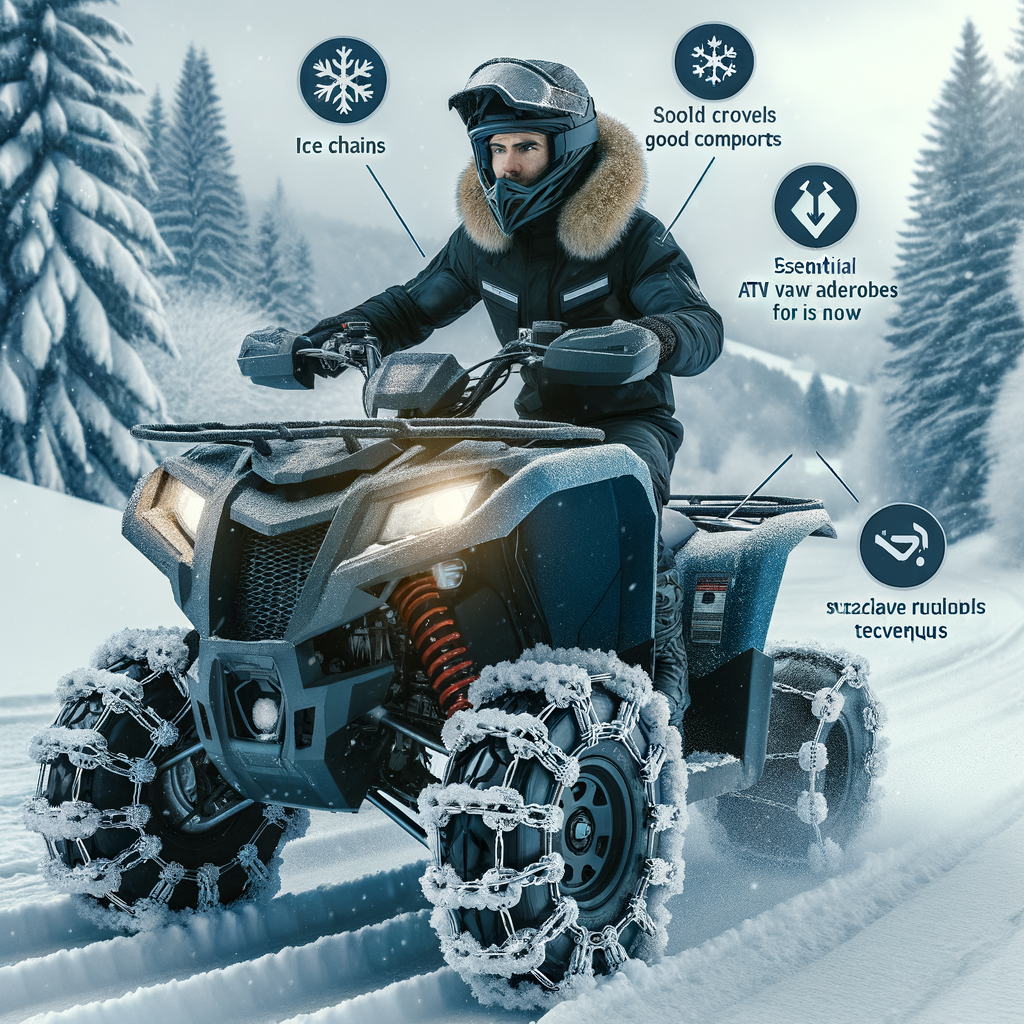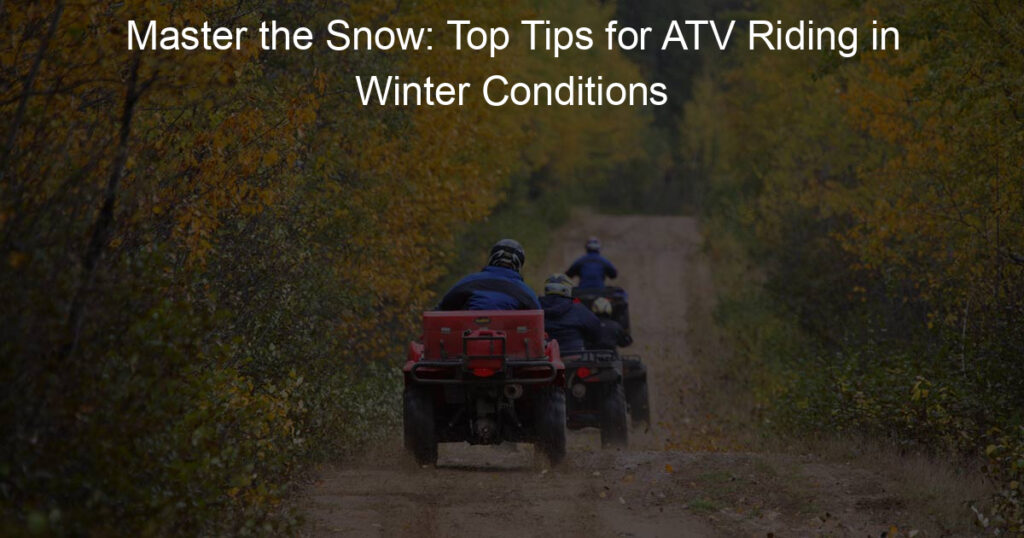
Introduction to Snow ATV Riding
When the snow starts to fall, it doesn’t mean that outdoor adventures have to come to a halt. In fact, it opens up a whole new world of excitement and challenges with snow ATV riding. This thrilling activity is not only a fun way to enjoy the winter season, but it also tests your skills and endurance in a unique way. Let’s delve into the world of snow ATV riding.
- Understanding the Challenges of ATV Riding in Snow
- The Thrill of All-Terrain Vehicle Snow Riding
ATV riding in snow is not as straightforward as it might seem. The snow-covered terrain presents a unique set of challenges that require a different approach compared to regular ATV riding. The slippery surface, reduced visibility, and cold temperatures are just a few of the obstacles you’ll have to overcome.
Firstly, the snow can make the ground slippery, making it harder to maintain control of the ATV. This means you’ll need to be extra careful when making turns or going over bumps. Secondly, snow can often reduce visibility, making it harder to see obstacles in your path. Lastly, the cold temperatures can be physically demanding, requiring you to wear appropriate gear to stay warm and safe.
Despite the challenges, snow ATV riding is an exhilarating experience that offers a unique thrill. The feeling of gliding over a blanket of fresh snow, the rush of cold air against your face, and the stunning winter landscapes are just some of the things that make this activity so exciting.
Moreover, snow ATV riding allows you to explore areas that might be inaccessible during other seasons. Whether you’re riding through a snowy forest or across a frozen lake, the opportunities for adventure are endless. Plus, the sense of accomplishment you get after successfully navigating a challenging snow-covered trail is truly rewarding.
In the following sections, we’ll delve deeper into the techniques of snow ATV riding, essential tips for a safe and enjoyable ride, and share some inspiring case studies of successful winter ATV riders. So, buckle up and get ready for an exciting journey into the world of snow ATV riding!
ATV Snow Riding Techniques
ATV snow riding is an exhilarating winter sport. However, it requires a certain level of skill and understanding to ensure safety and enjoyment. In this section, we will discuss some basic ATV snow riding techniques that every rider should know.
Basic Techniques
Before you venture out into the snow, it’s crucial to master some basic ATV riding techniques. These include how to properly mount and dismount, understanding the controls, and knowing how to start and stop safely.
- How to Properly Mount and Dismount
- Understanding the Controls
- How to Start and Stop Safely
Mounting and dismounting an ATV might seem simple, but doing it incorrectly can lead to injuries. To mount, approach the ATV from the side, grip the handlebars, and swing your leg over the seat. To dismount, reverse the process. Always ensure the ATV is completely stopped before you mount or dismount.
Knowing your ATV’s controls is essential for safe riding. The throttle, which controls speed, is usually on the right handlebar. The left handlebar typically houses the clutch and brake levers. The gear shift lever is often located near the left footrest. Always familiarize yourself with your ATV’s controls before riding.
Starting and stopping an ATV safely is crucial. To start, turn on the ignition, shift into neutral, and press the start button. Once the engine is running, shift into gear and slowly release the clutch while gradually applying throttle. To stop, gradually release the throttle and apply the brakes. Always remember to shift into neutral and turn off the ignition when you’re done riding.
Mastering these basic techniques is the first step to becoming a proficient ATV snow rider. In the next section, we will delve into some advanced techniques for riding an ATV in deep snow and managing steep slopes and uneven terrain.
Advanced Techniques
Now that we’ve covered the basics, let’s dive into some advanced techniques for ATV snow riding. These methods will help you navigate more challenging conditions, like deep snow and uneven terrain.
- How to ride ATV in deep snow
Riding an ATV in deep snow can be a thrilling experience, but it requires a bit more skill and knowledge. Here are some tips:
- Lower your tire pressure: This will increase the surface area of your tires, providing better traction in the snow.
- Use a slow, steady throttle: Rapid acceleration can cause your ATV to sink into the snow. Maintain a steady speed to stay on top of the snow.
- Lean forward: Shift your weight forward to help your ATV maintain balance and prevent it from tipping backward.
- Managing steep slopes and uneven terrain
Steep slopes and uneven terrain can be challenging, but with the right techniques, you can tackle them with confidence. Here are some strategies:
- Approach at an angle: When climbing steep slopes, approach at an angle instead of going straight up. This reduces the risk of flipping your ATV.
- Use your body weight: Shift your weight to counterbalance the ATV on uneven terrain. This helps keep the ATV stable.
- Go slow: It’s important to take your time and navigate carefully. Rushing can lead to mistakes and potential accidents.
Remember, practice makes perfect. The more you ride, the more comfortable you’ll become with these advanced techniques. Always prioritize safety and enjoy the thrill of ATV snow riding!
Essential Tips for Snow ATV Riding
When it comes to snow ATV riding, there are several key tips to keep in mind. These tips will not only ensure a smooth ride but also keep you safe in the snowy conditions. Let’s delve into these essential tips:
- Importance of Pre-Ride Inspection
- Wearing the Right Gear
- Safe ATV Riding in Snow: Dos and Don’ts
Before you hit the snow, it’s crucial to inspect your ATV thoroughly. A pre-ride inspection can help identify any potential issues that might cause problems during your ride. Check the tires for proper inflation and look for any signs of damage. Ensure that the brakes are working correctly, and the lights are functioning well. Also, check the oil and fuel levels. Remember, a well-maintained ATV is not only more reliable but also safer.
When riding an ATV in the snow, wearing the right gear is a must. This includes a helmet, goggles, gloves, boots, and suitable clothing. A helmet will protect your head in case of a fall, while goggles will shield your eyes from the snow and wind. Gloves and boots will keep your hands and feet warm and dry. As for clothing, opt for layers to stay warm and a waterproof outer layer to keep you dry. Remember, the right gear can make a significant difference in your comfort and safety.
Safe ATV riding in the snow requires a bit more attention and care than regular riding. Here are some dos and don’ts:
| Dos | Don’ts |
|---|---|
| Do ride at a safe speed considering the snowy conditions. | Don’t ride on ice-covered lakes or rivers. |
| Do use the body to shift weight and maintain balance. | Don’t ignore the signs of hypothermia or frostbite. |
| Do take frequent breaks to avoid fatigue. | Don’t ride alone, especially in remote areas. |
By following these tips, you can enjoy a safe and exciting snow ATV ride.
Case Studies: Successful Winter ATV Riding
Let’s delve into some real-life examples of successful winter ATV riding. These case studies highlight the importance of proper preparation, technique, and safety measures.
-
Case Study 1: Overcoming the Blizzard
Our first case study involves a group of friends who decided to take on a challenging winter ATV ride during a blizzard. They were experienced riders, but the blizzard presented a new set of obstacles.
The group prepared meticulously, ensuring their ATVs were in top condition and equipped with the necessary gear for snow riding. They also packed emergency supplies, including food, water, and first-aid kits.
Despite the harsh conditions, the group successfully navigated through the blizzard. They attributed their success to their preparation, teamwork, and adherence to safety guidelines. This case study underscores the importance of being well-prepared and taking safety seriously when riding in winter conditions.
-
Case Study 2: The Arctic ATV Adventure
Our second case study features an adventurous rider who embarked on an ATV journey across the Arctic. The rider, an experienced adventurer, had to contend with freezing temperatures, icy terrains, and limited daylight.
Despite these challenges, the rider managed to complete the journey successfully. He attributed his success to his extensive preparation, which included studying the terrain, equipping his ATV with snow-specific gear, and packing essential survival supplies.
This case study highlights the importance of preparation and understanding your environment when embarking on a winter ATV ride. It also shows that with the right approach, even the most challenging winter conditions can be conquered.
These case studies serve as real-life examples of how proper preparation, understanding of the environment, and adherence to safety guidelines can lead to successful winter ATV rides. Whether you’re riding in a blizzard or across the Arctic, the right approach can make all the difference.
Conclusion: Embrace the Snow
As we wrap up our discussion on snow ATV riding, let’s take a moment to reflect on the key takeaways and share some final thoughts on embracing the thrill of winter ATV riding.
- Recap of Key Takeaways
- Final Thoughts on Riding ATV in Winter Conditions
Throughout our journey, we’ve learned that snow ATV riding is not only a fun winter activity but also a skill that requires preparation and knowledge. We’ve discussed various riding techniques, essential tips, and shared inspiring case studies of successful winter ATV riders.
Remember, safety should always be your top priority. Equip your ATV with the right tires, maintain a safe speed, and always wear protective gear. Also, it’s crucial to understand the terrain and weather conditions before you venture out.
Lastly, practice makes perfect. The more you ride, the better you’ll get at handling your ATV in the snow. So, don’t be afraid to get out there and practice!
Winter ATV riding is an exhilarating experience that allows you to enjoy the beauty of nature in a unique way. It’s a challenge, but with the right preparation and mindset, it’s a challenge worth embracing.
Don’t let the cold weather deter you. Instead, see it as an opportunity to explore new terrains and create unforgettable memories. Remember, the thrill of riding an ATV in the snow is unlike any other.
So, gear up, stay safe, and embrace the snow. Happy riding!














